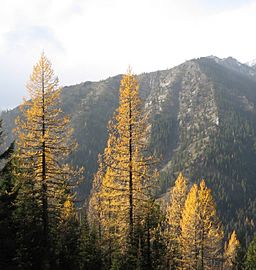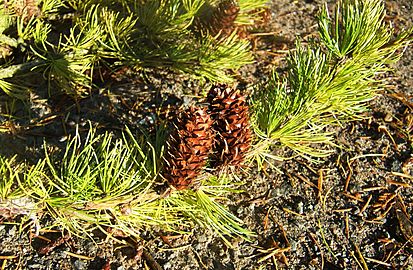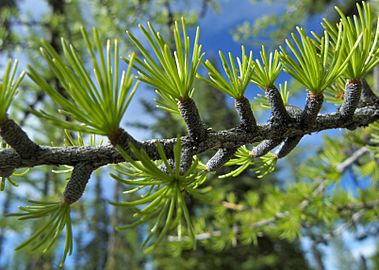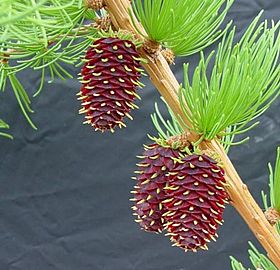Western larch facts for kids
Quick facts for kids Western larch |
|
|---|---|
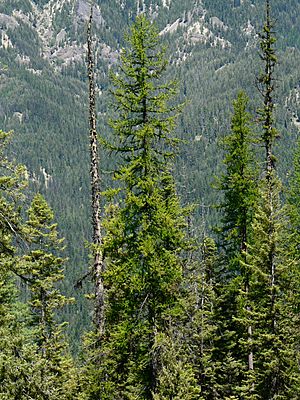 |
|
| William O. Douglas Wilderness Naches Valley, WA |
|
| Conservation status | |
| Scientific classification | |
| Genus: |
Larix
|
| Species: |
occidentalis
|
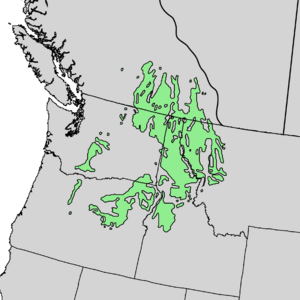 |
|
| Natural range of Larix occidentalis | |
The western larch (Larix occidentalis) is a type of larch tree. It grows naturally in the mountains of western North America. You can find it in places like southeastern British Columbia and southwestern Alberta in Canada. In the United States, it grows in eastern Washington, eastern Oregon, northern Idaho, and western Montana. This tree is the most common and productive of the three larch types found in North America.
Contents
What Does a Western Larch Look Like?
The western larch is a very tall tree. It can grow from 30 to 60 meters (about 100 to 200 feet) high. Its trunk can be up to 1.5 meters (about 5 feet) wide. The biggest known western larch is 46.6 meters (153 feet) tall. It has a circumference of 6.7 meters (22 feet) around its trunk. This giant tree is located near Seeley Lake, Montana.
This tree is a deciduous coniferous tree. This means it's a cone-bearing tree that loses its needles in the fall. Its top part, called the crown, is shaped like a narrow cone. The main branches grow straight out or point upwards. Smaller side branches often hang down.
The leaves are like needles, about 2 to 5 centimeters (1 to 2 inches) long. They are light green and very thin. In the fall, these needles turn bright yellow. Then they fall off, leaving the branches bare until spring.
Cones and Seeds
The western larch produces seed cones. These cones are oval-shaped and about 2 to 5 centimeters (1 to 2 inches) long. Each cone has 40 to 80 scales. Inside these scales are the seeds.
When the cones are young, they are reddish-purple. After four to six months, they turn brown. The scales open up to release the seeds. Old cones often stay on the tree for many years. They turn a dull gray-black color.
Where Western Larch Grows
Western larch trees grow at elevations between 500 and 2,400 meters (about 1,600 to 7,900 feet). They can handle very cold winters, surviving temperatures as low as -50°C (-58°F). However, they need soil that drains water well. They cannot grow in wet or waterlogged ground.
The seeds of the western larch are an important winter food for some birds. Birds like the pine siskin, redpoll, and White-winged crossbill eat them. They often rely on these seeds when other conifer cones are hard to find.
How People Use Western Larch
The Plateau Indian tribes used parts of the western larch. They would drink a tea made from young shoots. This tea was used to help with sicknesses like tuberculosis and laryngitis.
The wood of the western larch is very strong and lasts a long time. It can also be bent into thin strips, which makes it useful for building yachts. For yacht building, the wood needs to be very smooth and free of knots. This kind of wood comes from old trees that were trimmed when they were young. Smaller larch poles are also used to build rustic fences.
Western larch is also used to make a substance called Venice turpentine.
People in the Pacific Northwest really like to burn western larch wood for firewood. They often call it "tamarack," even though it's a different tree than the tamarack larch. The wood burns with a sweet smell and makes a unique popping sound.
Indigenous peoples also chewed gum made from the tree. They would also eat the inner bark, called cambium, and the sap. The sweet sap can even be used to make baking powder and medicine. Birds like grouse also eat the tree's leaves and buds.
Helping Western Larch Move North
In 2010, the Government of British Columbia started a special program. They began helping western larch trees move to new areas in Northern British Columbia. This new home is about 1,000 kilometers (620 miles) north of where they usually grow. This idea is called "assisted migration." It means helping trees move to new places.
This program was started because of climate change. As the Earth gets warmer, the best places for trees to grow are moving north. Studies showed that western larch trees could grow well in northern British Columbia. Scientists predicted that the climate there would be perfect for them by 2030.
British Columbia started planting western larch seeds in Northern BC in the early 2010s. This was the first time a North American tree was helped to move like this. The western larch was chosen because it's important for business. There was a worry that climate change and bugs like the mountain pine beetle would harm the trees. To avoid arguments, the government presented this as moving a tree to a similar environment. They used existing laws to make it happen.
Gallery
See also
 In Spanish: Alerce americano occidental para niños
In Spanish: Alerce americano occidental para niños



